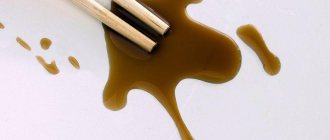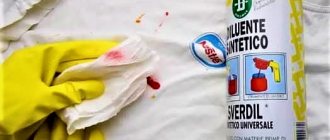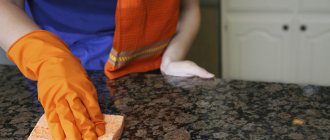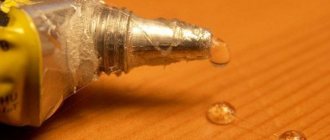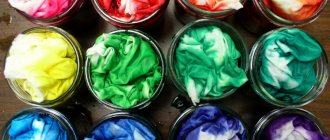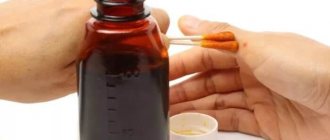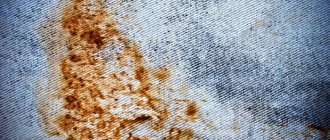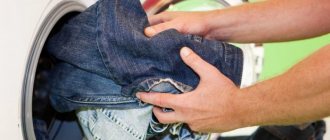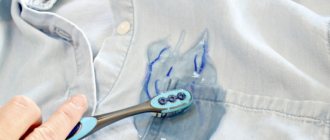Paint on children's hands is a common occurrence. No matter what creativity they do, corrosive stains still remain on the skin.
If regular hand washing with soap does not help, then the matter is serious and you cannot do without special means. We suggest using one of 5 recipes for effective paint removal.
The methods listed below are safe for young children, but parents should monitor for skin sensitivity and irritation.
How to get rid of gouache on white clothes?
How to remove gouache from a white shirt? Mix 1 teaspoon of butter with a good laundry detergent, then rub the mixture into the stains. Leave the clothes to soak for 30 minutes, then wash the treated item by hand in soapy water.
Interesting materials:
What to do with a puff on jeans? What to do with an old bank card? What to do with an old photograph from a grave? What to do with old furniture? What to do with an old passport? What to do with old calendars? What to do with the old ones? What to do with your wedding dress after a divorce? What to do with fresh mushrooms processing? What to do with Xenia of St. Petersburg?
Do all paints remove equally?
First of all, you need to find out what type of paint caused the problem. If the stain has only recently appeared, it will be much easier to remove it. If the paint dissolves in water, laundry soap can handle it. Currently, there are a large number of different paints, significantly different in composition. Compared to watercolors or gouache, which can be easily washed off, you will have to tinker with oil and acrylic paints longer.
Watercolor paints can be removed with soap and water.
Holi colors used during fun festivals are also difficult to wash off. They are made on the basis of natural dyes, which are very difficult to wash off.
Holi colors don't always wash off
What not to do
When removing gouache stains, it is not recommended to do the following:
- If possible, do not wait for the gouache to dry. A fresh stain is easier and faster to remove without leaving a trace.
- You should not wash things with boiling water; it is better to soak and rinse the contaminated area with cool water.
- It is prohibited to use solvents to remove stains from synthetic fabrics.
- Solvents should not be used in unventilated areas.
- When using flammable substances such as gasoline or acetone, do not work near open flames.
- Do not remove stains with aggressive agents without protecting your hands with gloves.
Features of removing various types of coloring agents
The best result of hand cleansing can be obtained if you know exactly what composition left the stains. Even inks such as stamp inks and those used in printers require a separate approach to removal.
Refill for printer and printing
If the printer toner is water-based, then fresh stains can be washed off the skin with regular running water . Be sure to wash your hands with cold water.
Otherwise, instead of washing, you can get the opposite result - fixing the color.
You can additionally use laundry soap, washing powder, or a brush to clean your hands.
Toner manufacturers provide for the dye to set when exposed to high temperatures, which is why you should not wash your hands in hot water.
The principle of operation of inkjet printer inks, which are made on an oil basis, is to impregnate layers of paper.
The same thing happens with the skin of your hands. When washing, it is possible to wash off only the top layer of dye .
The pigment will disappear completely only after a few days. One option for using home remedies is to use a recipe based on washing powder and citric acid. You can speed up the process by washing your hands frequently.
In addition to the methods listed, it is recommended to use products that are designed to remove printing and other types of inks.
- special cleaner Strong & Safe Flexographic ink Hand Cleaner;
- Fast Orange Pumice Bar Hand Soap;
- deep cleaning lotions, etc.
Construction and art
You can remove stains left by water-based paints from your hands by washing your hands with soap and water. If the pigment is difficult to remove, it is recommended to rub the skin with the hard side of a washcloth or brush.
For acrylic, nitro enamel and enamel, the role of solvent is played by:
- acetone,
- petrol,
- White Spirit.
Oil products can also be used. The water emulsion, if it has dried, can be washed off by washing your hands with washing powder and using a brush. Caustic washes and paint thinners should not be used to clean hands, as they can cause chemical burns.
For hair
You can remove hair dye from your hands by simply washing with water if the problem was noticed right away.
Over time, you will have to use either a professional remover or put into practice recipes based on oil products, citric acid, washing powder, etc.
What not to do
When removing gouache stains, it is not recommended to do the following:
- If possible, do not wait for the gouache to dry. A fresh stain is easier and faster to remove without leaving a trace.
- You should not wash things with boiling water; it is better to soak and rinse the contaminated area with cool water.
- It is prohibited to use solvents to remove stains from synthetic fabrics.
- Solvents should not be used in unventilated areas.
- When using flammable substances such as gasoline or acetone, do not work near open flames.
- Do not remove stains with aggressive agents without protecting your hands with gloves.
If paint gets on the sofa or carpet
If you accidentally spill paint on your couch or rug, the first step is to place a few paper napkins or towels around the stain to prevent it from spreading across the surface. Use a towel to gently blot the stain itself. Then, depending on the type of paint, different methods can be used.
Cleaning up acrylic paint stains
- Cover the stained area with a napkin containing glycerin.
- Use acetone or nail polish remover to dissolve the stain.
- Wipe off any residue with a soapy solution using a clean rag or sponge, without overly moistening the surface of the furniture or carpet.
- Dry the wet area of the product with a dry towel.
- Vacuum the carpet or sofa.
Nail polish remover will help remove acrylic paint from upholstered furniture
How to remove dried acrylic paint
- Using a knife, scrape it off the surface of the sofa or carpet.
- Spray the stain with WD-40.
- After 20 minutes, remove the stain. You may need to use a knife.
- Wash the treated area with soapy water and dry it.
WD-40 solvent will remove dried acrylic paint
Instructions for removing latex and emulsion paints from carpets
To remove latex paint stains:
- Blot the stain with a dry cloth.
- Moisten it with water while wiping it with gentle movements from the edges to the middle.
- Scrub the dirt with a soft bristled brush using a soapy solution.
To remove emulsion paint, do the following:
- Blot the stain with a dry cloth.
- Place a cloth soaked in apple cider vinegar on the stain, but do not scrub.
- Once the paint has soaked into the rag, turn it over to the clean side down. Try to remove the stain, changing the cloths soaked in vinegar if necessary.
- Wash away any remaining dirt with soapy water.
- Dry the surface to be treated.
Apple cider vinegar can dissolve emulsion paint
Cleaning oil paint with turpentine
- Blot the stain with a clean paper towel.
- Apply turpentine to it. When the dirt dissolves, remove it.
- Wash off any remaining solvent with purified gasoline.
- Wash the area to be treated with soapy water and dry it.
Remove oil paint from clothes with turpentine
How to remove stains from wallpaper
- It is most difficult to remove stains from paper wallpaper, since they become wet when exposed to liquids.
- If a small watercolor stain has formed on the wall, you can wipe it off with a damp cloth.
- More serious stains from oil, acrylic paints or gouache can be removed using solvents: without rubbing the stain on the surface, blot it with a cotton swab dipped in the product, and after a few minutes wipe with a clean rag or napkin, removing it.
Attention! Before using any product, test it on an inconspicuous area of the wallpaper.
How to remove different types of dyes from clothes
Paint stains on clothes cause the most trouble. Not everyone can afford the services of professional dry cleaners. You can cope with this problem yourself using the following recommendations.
How to remove oil paint stains
If fresh stains need to be removed, use vegetable oil.
- Apply it to the stain using a cotton swab.
- Lightly scrub the surface.
- After the oil has diluted the paint, get rid of the greasy stain using salt, gasoline, and acetone.
You can remove a greasy oil stain using starch.
- Apply the substance to the contamination.
- Place a clean sheet of paper on top and iron it with an iron.
Gasoline intended for refilling lighters, acetone or turpentine will also help deal with a fresh stain. Treat the fabric with any of these substances. Then wash your clothes. It is not recommended to use these products to remove paint from delicate fabrics.
Sometimes the stain can be washed off with liquid soap in low-temperature water.
- Pour liquid soap onto the stain and let it thoroughly saturate the fabric.
- Using a clean rag, gently wipe away the stain.
Liquid soap will remove fresh paint stains from the fabric.
If the stain is not fresh, you should proceed in stages.
- Remove any remaining paint using a knife.
- Soften the stain with any solvent (acetone, turpentine, gasoline, vegetable oil) or stain remover. Typically this process takes about 30 minutes.
- Using a sponge or piece of thick cloth, thoroughly rub the stain.
- Do a normal wash.
The method is highly effective. But if clothes made from synthetic fibers, wool, cashmere and leather have been damaged by oil paint, it is not safe to use solvents. The same sunflower oil will help remove contamination.
How to remove gouache, watercolor, tempera from clothes
Even if watercolors or gouache have dried to the fabric surface, ordinary washing in a machine will not leave a trace of them, since they dissolve well in water.
Laundry soap easily removes fresh paint stains
Tempera can be removed with dishwashing detergent.
- Apply detergent to the stain.
- Rub it lightly.
- Rinse clothes in clean water and wash if necessary.
To avoid complex stains, add a few drops of liquid soap to the tempera before starting work. This will make it easier and faster to remove the stain in the future using only soap and water.
Fairy dishwashing liquid will dissolve the fats present in tempera
Removing acrylic and latex paint
Fresh stains from these dyes can be easily removed: hold the clothes turned inside out in cold water, wring them out well and wash them in a machine at 30 °C on the longest setting. If traces remain, proceed as follows.
- Sprinkle washing powder onto the stain.
- Using a toothbrush, scrub the stained area.
- Rinse the stain with hot water.
- Wash the product in a machine at high temperature.
If this doesn't help, use a stain remover.
When removing acrylic paint from clothes, you cannot do without a washing machine.
Removing water-based paint with alcohol
Regular alcohol will help dissolve such contaminants. The method is very effective and does not require any special costs.
- Apply it to the fabric surface using a swab.
- Rub the stain lightly.
- Carry out a normal wash.
If you don't have alcohol on hand, you can soak the item in soapy water and wash it by hand.
Ethyl alcohol successfully copes with water-based paint
How to remove stains from alkyd enamel
Use White Spirit:
- Place a clean rag under the affected area of fabric.
- Apply the substance to the stain and lightly rub it using a cotton swab.
- Remove the stain and wash the clothes with laundry soap.
White spirit is a universal solvent that can remove paint stains
Denim fabric, which is highly durable, tolerates treatment well with any of the listed compounds. The described methods are also effective in removing Holi colors.
How to remove paint marks from clothes - video
How to remove paint from linoleum
If paint gets on the linoleum during the work, do not despair.
- If it is a water-based suspension, simply wipe it off with a damp cloth.
- Remove oil-based paint with a napkin, then apply sunflower oil to the stain and wash off the stain with any cleaning agent.
- If the nature of the paint is unknown, use a solvent - acetone, white spirit, solvent 646. First perform a test on an inconspicuous area of the product.
Any solvent, for example, white spirit, will help get rid of paint stains on linoleum.
Properties of “traces of creativity”
Paint marks, unlike some other stains, are absorbed fairly quickly. Coloring pigments penetrate into the fibers of the material, which makes the removal process much more difficult. It is this property of paints that determines the relationship between the speed of getting rid of the stain and the success of the operation. Watercolor and gouache have an adhesive base, which means they are easily washed off with water. Face painting is a popular summer pastime for children and adults; its very name indicates that it is water-based. So “they knock it out with wedge.” Holi festival colors are created using flour and food coloring. To remove them, do not wet the item until you remove the dried layer by shaking it off the stained surface.
Children enthusiastically devote themselves to drawing, so they do not particularly care about accuracy
Attention! If the paint dries quickly, it contains a synthetic compound that is hazardous to health - polyvinyl chloride. It causes an allergic reaction and affects the nervous system, liver and kidneys. On the packaging, pay attention to the presence of so-called R-phrases, which are characteristics of the safety of the product. R36 or R20/22 indicates that the substance is hazardous if inhaled and swallowed and is irritating to the mucous membrane of the eyes.
Before you buy paint for your child, you should familiarize yourself with the composition.
Tips and tricks
You can wipe off gouache from clothes and other surfaces faster if you remember a few important rules:
- Paint marks cannot be washed away with hot water, even if the gouache is fresh. High temperature treatment only makes the stain stronger.
- It is customary to wash away any dirt from the edges to the center; if you do the opposite, the stain can only be smeared.
- For gouache stains on clothes, gentle agents are always used first and only then, if there is no effect, they move on to aggressive solvents, alkalis and acids.
When trying to remove gouache from clothes at home, it is recommended to use rubber gloves and a face mask. Some products have a strong odor and emit pungent fumes that are hazardous to health.
Paint stains on hands
If paint gets on unprotected areas of your hands during work, vegetable oil will help get rid of it. Using it, you can do without the use of chemical compounds and solvents. It is enough to wipe the contaminated areas with oil, and after a few minutes wash off the paint with soap.
Paint stains on your hands can be wiped off with sunflower oil.
